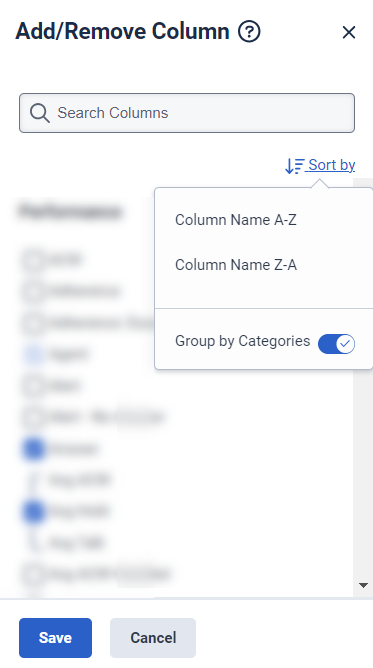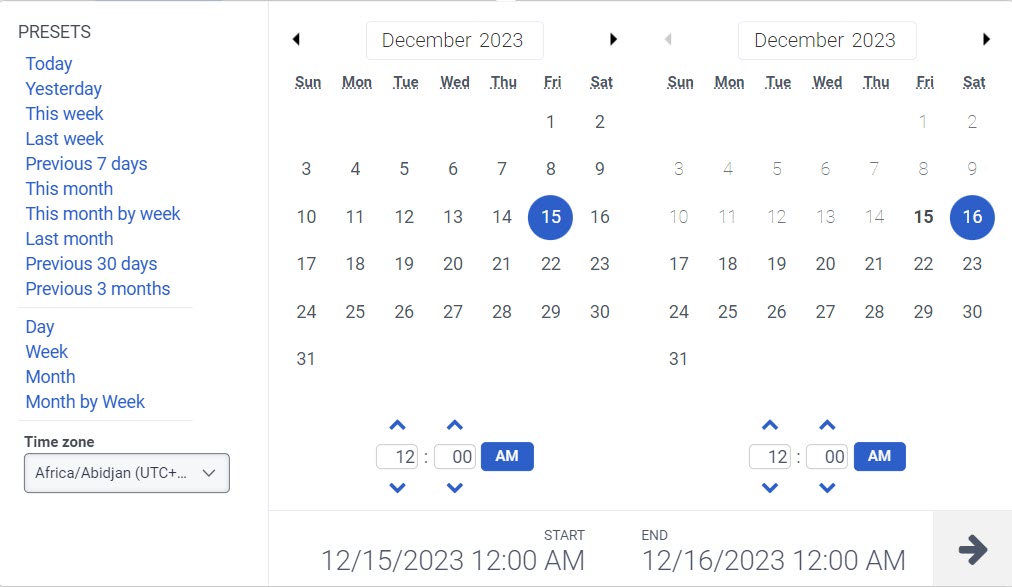Journey Action Maps Summary view
Prerequisites
The following permissions:
- Journey > Action Map > View
- Analytics > Journey > Aggregate > View
- Journey > Outcome > View
- Journey > Segment > View
- Journey > Action Map > Add (to duplicate an action map)
- Journey > Action Map > Delete (to delete an action map)
- Journey > Action Map > Edit (to activate or deactivate an action map)
The Journey Action Maps Summary view displays metrics about the effectiveness of your action maps. For example, the number of times an action map qualified to be offered to a visitor. Learn how visitors interacted with a specific action map and if the outcome of the action map was achieved. For more information about Genesys Predictive Engagement action maps, see About action maps.
Available columns
To view the available columns, see Journey Action Maps Summary view section in the View available columns in performance views by category article.
To view the consolidated list of available columns in the performance views, see Consolidated view of available columns in performance views.
To view the list of available columns in the performance views by category, see View available columns in performance views by category.
Extra columns for export
The export file contains extra columns.
| Column | Description |
|---|---|
| Interval Start | The start of the time period selected for the export. |
| Interval End | The end of the time period selected for the export. |
| Interval Complete | True if the export was run after Interval End, and false otherwise. |
| Filters | Any filters applied to the export. |
| Aggregate or Detail | Aggregate is the primary row. Related Detailed subtable rows are below the Aggregate row. |
| Outcome ID | The ID for the journey outcome. |
| Action Map ID | The ID for the journey action map. |
| Segment ID | The ID for the journey segment. |
Set a default time zone in the workspace
You can set the default time zone in the analytics workspace before viewing any analytics view.
To set the default time zone in the workspace, follow these steps:
- Click Performance > Workspace.
- On the left side, from the Time zone drop-down menu, select the required time zone as the default time zone for the analytics workspace.
To view action map metrics, click Performance > Workspace > Journey > Journey Action Map Performance. Customize the view with filters and column controls.
To save the view with your filter and column settings, click Save .
To export the data in the view, click Export .
This view does not automatically update. To see the latest metrics, click Refresh .
To create an action map, which uses different types of actions to enhance and extend a visitor’s journey, from the Journey Action Maps view, click Create action map.
Customize the view
Customize the Journey Action Maps Summary view to show only certain data. For example, you can choose to show only certain columns or filter to see certain types of action map metrics. Your customizations remain in effect even if you leave and return to the view. You can also save your filter and column settings as a saved view to switch quickly between different data of interest in the same view.
To filter by action map name, type the first few letters of the name in the Filter by Action Maps field and then select the item from the list.
- The custom date range option in this view has a maximum length of 93 days.
- The date range filter applies to when visitor activity starts. Current visitor activity that started before the date range isn’t included in the action map metrics.
To customize analytics views, use the date filter.
To filter metrics by date or configure a custom date range, use presets. When filtering metrics for this view, select any custom date range up to 6 weeks.
To use a preset to filter metrics, complete the following steps:
- To display the date filter, click the date.
- In the Presets list, select a preset date option.
Date presets
| Presets | Description |
|---|---|
| Today | Shows data for the time period that includes the current interval. |
| Yesterday | Shows data for the previous day. |
| This week | Shows data for a Sunday through Saturday time period. |
| Last week | Shows data for the previous week, Sunday through Saturday. |
| Previous 7 days | Shows data for the previous seven days. |
| This month | Shows data for the current month, with no extra days. |
| This month by week | Shows data for the current calendar month starting on Sunday and ending on Saturday, including extra days if the month does not start on Sunday or end on Saturday. |
| Last month | Shows data for the previous calendar month with no extra days. |
| Previous 30 days | Shows data for the previous 30 days. |
| Previous 3 months | Shows data for the previous 3 months. For example, Nov 1, 2022 – Jan 31, 2023. |
| Day | Shows data for a single 24-hour day. |
| Week | Shows data for a Sunday through Saturday time period. |
| Month | Shows data for the exact month with no extra days. If the current month is selected, you can see the data up to the current date. |
| Month by Week | Shows data for a calendar month starting on Sunday and ending on Saturday, including extra days if the month does not start on Sunday or end on Saturday. |
To use a custom date range to filter metrics, complete the following steps:
- Click the date to display the date filter.
- Select a start date and an end date on the calendar, and click the filter arrow .
To view data for a different time period using the same date presets, click the arrows on either side of the date display. ![]()
For example, to view data for the previous day, click the Day preset, and then click the arrow on the left side of the date.
To view data for a different time zone using the same date presets, from the Time zone drop-down menu, select the required time zone. You can create and save reports with the same selected time zone.
To show or hide columns:
- Click the Pick columns icon on the right side. The Add/Remove Column pane appears.
- (Optional) To sort the columns in ascending or alphabetical order, click Sort by > Column Name A-Z.
- (Optional) To sort the columns in descending or reverse alphabetical order, click Sort by > Column Name Z-A.
- (Optional) To categorize or uncategorize the columns, click Sort by and enable or disable the Group by Categories toggle. Click the image to enlarge.

- Search or scroll to select the columns you want to view. Note: You can also use keyboard navigation to choose the columns.
- Click Save. The selected columns appear on the screen. Note: The column selections appear only after saving the changes and do not apply to the table immediately.
To rearrange the columns, click a column header and drag it.
To reset a view to default column settings, click Reset view to defaults ![]() .
.
You can select up to 20 columns.
For more information about the metrics shown in the columns, see the Available Columns section in this article.
For more information about the metrics shown in the columns, see Available Columns below.
To filter by action map types, click Filters. Use the Action Map Type filter to display data, by action type, for your action maps. Filter by action map types Architect Flow, Content Offer, Integration Action, Web Messaging Offer, and Webchat. For more information about action map types, see Create an action map.
To filter by journey outcome or segment, type the first few letters of the name in the Journey Outcome or Segment field and then select the item from the list.


